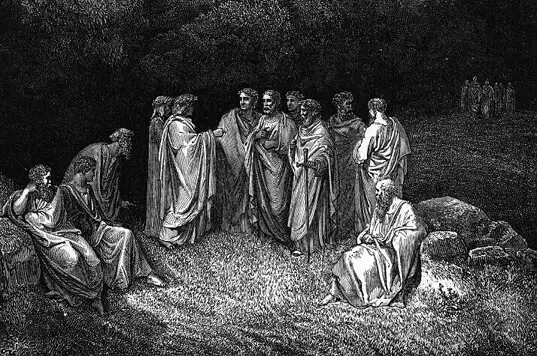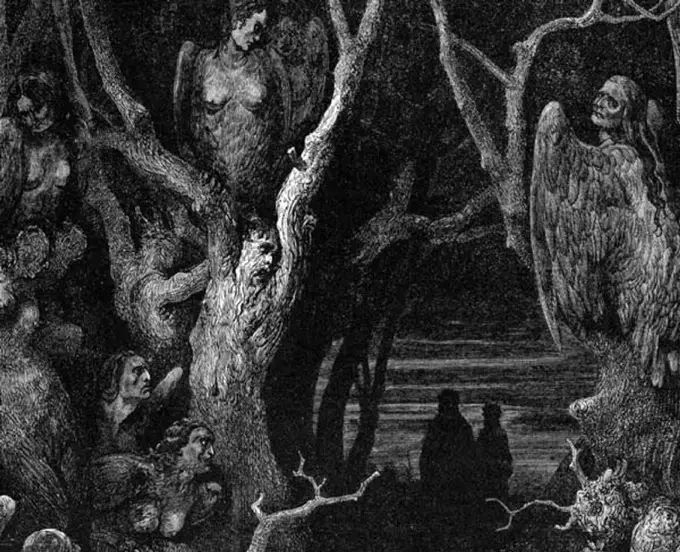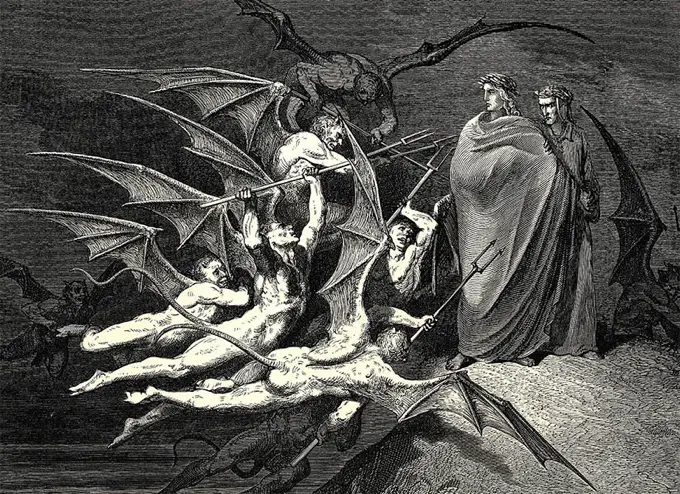Dante Alighieri first described the Nine Circles of Hell in his epic poem Divine Comedy. It is a long narrative poem in the Italian language.
The poem has three parts, and the narrative describes Dante’s journey through the three realms namely Inferno, Purgatorio, and Paradiso. Inferno has been illustrated by one of the most famous artists Gustave Dore.
He is guided and accompanied by Virgil, an Ancient Roman poet from the time of Roman Emperor Augustus. The nine circles of Hell are described in the first part of the poem, Inferno, and influences literature of all periods. Each circle represents sin and the punishment deserved by one who commits the sins.
The circles are divided into two parts- the Upper Hell and Lower Hell. The first sin is self-indulgence such as Lust, Gluttony, Greed, and Wrath.
The two to five circles are for the Upper Hell. Circle seven is for violence and circles eight and nine are for fraud. Dante added circle one for Limbo, and circle six for Heresy.
First Circle of Hell- Limbo
Content

According to the poem, Dante, along with Virgil, arrives at Limbo, the First Circle of Hell. They had to cross the river Acheron on a boat to reach Limbo. The literal meaning of Limbo is ‘boundary’ or ‘edge.’ The First Circle contains people who did not accept Christ.
Limbo is filled with virtuous pagans, and people who were never baptized. The people who don’t have enough faith to enter Heaven, but also were not sinful are sent to Limbo.
According to the poem, many prominent and influential public figures like Aristotle, Julius Caesar, Hippocrates, Cicero, Socrates, and Homer reside here. Although people are not tortured, there is the presence of sadness and gloominess. The people’s soul in Limbo is unhappy. Although heaven is near, they won’t be able to enter.
Second Circle of Hell- Lust

Limbo is succeeded by the Second Circle of Hell. People who were driven by Lust are tormented here. In the poem, Dante says that strong violent winds blow in the Second Circle of Hell.
The violent winds drag and beat the tormenting souls on the rocks and mountains. It symbolizes the supremacy of lust over the people which drives them to satisfy their never-quenching thirst.
According to the poem, Dante sees many adulterous people such as Cleopatra, Dido, Helen of Troy, Tristan, Semiramis, and many more over here.
Dante considers lust as a less-heinous crime as it involves more of mutual indulgence rather than being self-centered. This could be a reason why Lust is the Second Circle of Hell.
Third Circle of Hell- Gluttony

In the Third Circle, the souls of the people who indulged in voracious feasting and appetite are tortured. The whole landscape is filled with putrefying mud and living organs.
The souls are punished by the icy and violent storm which rained foul, decaying sludge and mud onto them. The storm also rained worms and human wastes upon them.
They are forced to gurgle around in the solid waste and mud. The monstrous dog beasts with three heads also lived in this circle.
The souls are tormented not only for their overindulging excessive eating and drinking but also for their other addictions. Unlike Lust, Gluttony is a self-centered sin, and, hence it is considered much more heinous.
Fourth Circle of Hell- Greed
The person who condemns the sin of greed is punished in the fourth circle of hell. The Circle is divided into two groups of people- the ones who spent lavishly and those who hoarded for the great and imperial possession, which is irrelevant.
Plutus, the God of Wealth, guards the inner circle of greed. It includes cardinals, clergymen, and also the popes who accumulated possession and wasteful extravagance and foolishly misused others’ money for their own benefits.
It refers to people as if they lost their soul and carry a huge weight on the chest; they themselves choose to suffer to attain higher possession.
The greed indulgence of two parties has lured them into the self-pity of misery and lies, which is never enough to suffice their appetite for never-ending greed. Hoarding and squandering have led to the indifference to come to mutual antagonism.
Fifth Circle of Hell- Wrath
The fifth Circle of Hell is present in the stinking, decaying water of the Styx river. In this Circle live the souls who lived their entire life wrathfully. According to the poem, Dante along with Virgil find the souls to fight each other furiously on the surface of the Styx river.
Depending on the severity of their wrathful actions they sink in the river water. It reflects the type of sins they committed in their life. People who indulged in a silent sullen lie just below the surface. The people who were highly driven by their anger struggled deep inside the river.
The souls struggle and fight each other for eternity. They choke each other and stop each other from expressing or speaking. The act represents their anger which when expressed would harm other people.
Sixth Circle of Hell- Heresy

The Sixth Circle of Hell marks the beginning of Lower Hell. The souls being tortured in the successive Circles committed heinous crimes and are punished with a severely tortured climate. The souls of people who denied the cores of Christianity are trapped in flaming hot tombs.
Seventh Circle of Hell- Violence

The souls of people who indulged in violence are put to punishment and torture in the Seventh Circle of Hell. It is further divided into three Rings. The souls are sent to suffer in the circles depending on the severity of their violence.
The First Ring tortured the souls of people who are violent against their neighbors. The Second Ring torments the souls of people who were violent towards themselves. The Third Ring has souls of people who showed violence against God, Nature, or Art.
In the First Ring of Seventh Circle, the souls of people who committed violent crimes against other humans are being tortured. It includes criminals like murderers, tyrants, war-makers, looters, and many more. Their souls are dipped in sweltering blood and flames of the river Phlegethon.
The souls are dunked in the variable depths which represent their lust for blood. The higher the sins of a person were, the deeper his soul is submerged to struggle in the scorching blood.
There are creatures such as Centaurs, half-human, and half-horse present here. They would shoot arrows at the sinners who would try to emerge out of the boiling blood more than they are allowed.
According to the poem Divine Comedy, Dante and Virgil see the world’s powerful kings and tyrants such as Alexander the Great, Ezzelino III da Romano and Dionysius here.
They all are suffering and being tortured because of their never-ending desire to conquer the world. Their desire corrupted their minds and led them to kill thousands of people.
In the Second Ring of Seventh Circle, the souls of people who committed suicide or attempted to do so are tortured for eternity. The souls are malformed into Thorny Gnarled tree. Harpies, half-human half-bird creatures, feed on them.
The punishment symbolized self-hatred which dried them up and turned them into dead trees. They have no energy but are subject to cuts and bleeding just like they did in their lifetime.
In the last ring, the Third Ring of Seventh Circle of Hell, people who committed crimes like blasphemy, sodomy, and bestiality and the unfair money lenders are being tortured.
The whole landscape depicts the miserable end of Sodom and Gomorrah. It is all covered by the scorching-hot burning sand and flakes of flames fall from the sky.
In the poem, Dante mentions seeing the Blasphemers lying on the burning sand and the sodomites running in circles on the sand. The unfair money lenders are weeping and huddled on the sand.
Eighth Circle of Hell- Fraud

The Eighth Circle of Hell is Malebolge, meaning Evil Ditches. This is the place where people who committed fraud and malicious crimes are tortured.
This circle is divided into Ten Ditches or Bolgia. In the First Bolgia, panderers sex workers, and seducers are tortured. They are whipped by the demons for they exploited others by seducing them to fulfill their interests.
In the Second Bolgia, flatterers are being tortured who exaggeratedly complimented others on gaining their attention and on corrupting them.
In the Third Bolgia, Simoniacs who sold the church’s roles and offices are punished. In the poem, Dante sees Pope Nicholas III as being a corrupt pope.
In the Fourth Bolgia, sorcerers such as diviners, fortune tellers, astrologers, and other false prophets are tormented.
The fortune-tellers had their heads twisted backward as they wanted to see the future by means of black magic. They desire to see what lay ahead caused them damnation. The sinners are now bounded to walk backward and their own tears blinded them for eternity.
In the Fifth Bolgia, politicians who sold their public offices for money are punished. They are dunked in boing pitch for indulging in corruption and betraying their country. In the poem, Dante mentions a clawed demon called Malebranche who would tear them apart if they tried to come above the surface of the pitch.
In the Sixth Bolgia, all the hypocrites are punished for the false status they built in the society for themselves. They are made to climb a mountain with heavily leaden robes which would weigh them down.
In the Seventh Bolgia, all the thieves are punished. They are tormented in a huge pit filled with snakes, lizards, and other reptiles which would bite them and curl around their hands, legs, back, and neck.
In the Eighth Bolgia, the counselors of deception and fraud are punished. The fraudulent advisors and evil counselors are covered by individual flames. They all are being punished for their false advisory and pieces of advice to conduct fraud or deception.
In the ninth Bolgia, people who separated religion to form their own religion are being punished. They are mutilated for their sins for eternity.
In the tenth Bolgia, the falsifiers are tortured. Alchemists, counterfeits, impersonators, perjurers, and others are subjected to terrible diseases, filth, thirst, disgusting odor, screaming, and darkness.
See Also:
Ninth Circle of Hell- Treachery

The Ninth Circle of Hell is a frozen lake called Cocytus. It also has Here Centre of Hell, where Satan resides. The souls are frozen in the depths of the Lake depending on the type and severity of their sins. The ones who committed a more severe crime or sin are buried deeper. The Ninth Circle is divided into four Rounds.
The First Round of Ninth Circle is called Caina, named after Cain who murdered his own brother Abel. Here, the souls of people who betrayed their own family and kin are freezing for eternity. Their neck and head are above the ice so that they could bow and protect themselves from the biting cold winds.
The Second Round of Ninth Circle is called Antenora named after Antenor. He was the soldier from Troy who cheated on his own city to the Greeks. Here, the souls of people who betrayed their country are punished.
The Third Round of the Ninth Circle is called Ptolomaea, called after Ptolemy. He called his father-in-law along with his sons for a treat and killed them. Here, traitors who betrayed their guests are punished.
The Fourth Round of Ninth Circle is called Judecca named after Judas Iscariot. The traitors against God are frozen into an immobile and distorted ice statue. There is complete silence in this round.
After crossing Judecca comes the Centre of the Hell. People who committed the absolute sin of treachery against God are punished here. Here, Satan resides who is trapped in the frozen central zone in the Ninth Circle of Hell. Also, Lucifer, the archangel who betrayed God is trapped waist-deep in the ice.
